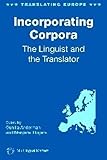Incorporating Corpora : The Linguist and the Translator / ed. by Gunilla Anderman, Margaret Rogers.
Material type: TextSeries: Translating EuropePublisher: Bristol ; Blue Ridge Summit : Multilingual Matters, [2007]Copyright date: ©2007Description: 1 online resource (250 p.)Content type:
TextSeries: Translating EuropePublisher: Bristol ; Blue Ridge Summit : Multilingual Matters, [2007]Copyright date: ©2007Description: 1 online resource (250 p.)Content type: - 9781853599866
- 9781853599873
- 418/.02 22
- P306.2 .I525 2008
- P306.2 .I525 2008eb
- online - DeGruyter
| Item type | Current library | Call number | URL | Status | Notes | Barcode | |
|---|---|---|---|---|---|---|---|
 eBook
eBook
|
Biblioteca "Angelicum" Pont. Univ. S.Tommaso d'Aquino Nuvola online | online - DeGruyter (Browse shelf(Opens below)) | Online access | Not for loan (Accesso limitato) | Accesso per gli utenti autorizzati / Access for authorized users | (dgr)9781853599873 |
Frontmatter -- Contents -- Acknowledgements -- Contributors: A Short Profile -- Introduction -- Chapter 1. The Linguist and the Translator -- Chapter 2. Parallel and Comparable Corpora: What is Happening? -- Chapter 3. Universal Tendencies in Translation -- Chapter 4. Norms and Nature in Translation Studies -- Chapter 5. Being in Text and Text in Being: Notes on Representative Texts -- Chapter 6. Translating Discourse Particles: A Case of Complex Translation -- Chapter 7. The Translator and Polish–English Corpora -- Chapter 8. The Existential There-construction in Czech Translation -- Chapter 9. Corpora in Translator Training and Practice: A Slovene Perspective -- Chapter 10. NP Modification Structures in Parallel Corpora -- Chapter 11. AStudyof theMandativeSubjunctive in French and its Translations in English: A Corpus-Based Contrastive Analysis -- Chapter 12. Perfect Mismatches: ‘Result’ in English and Portuguese -- Chapter 13. Corpora for Translators in Spain. The CDJ-GITRAD Corpus and the GENTT Project
restricted access online access with authorization star
http://purl.org/coar/access_right/c_16ec
The emergence of studies of translation based on electronic corpora has been one of the most interesting and fruitful developments in Translation Studies in recent years. But the origins of such studies can be traced back through many decades, as this volume sets out to establish. Covering a number of European languages including Czech, Hungarian, Polish and Slovenian, as well as French, Spanish, Portuguese and Swedish, the book presents many new studies of translation patterns using parallel corpora focusing on particular linguistic features. The studies reveal systemic differences which are in turn, of relevance to the linguistic description of the languages concerned, as well as to translator training. Also included are broader-ranging contributions on the concept of translation universals, including a critical perspective on this popular topic. [127 words]
Mode of access: Internet via World Wide Web.
In English.
Description based on online resource; title from PDF title page (publisher's Web site, viewed 01. Dez 2022)


